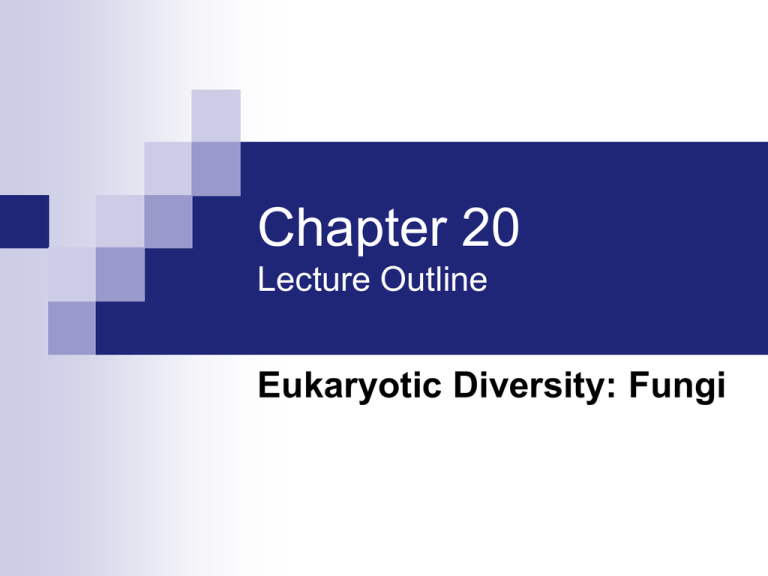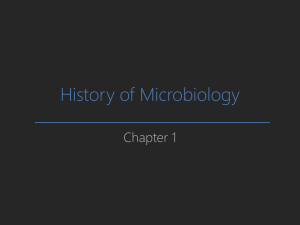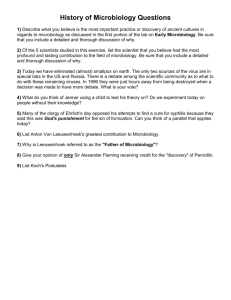Chapter 1 Art Slides
advertisement

Chapter 20 Lecture Outline Eukaryotic Diversity: Fungi Phylogeny of Eukaryotes Eukaryotes have greatest diversity of size and shape Unicellular Fungi Algae Protozoa Multicellular Complex multiorgan species Less diverse metabolism than prokaryotes 50- 90% of their DNA consists of non-coding sequences Microbiology: An Evolving Science © 2009 W. W. Norton & Company, Inc. 2 Phylogeny of Eukaryotes Based on Molecular and Morphological Data Microbiology: An Evolving Science © 2009 W. W. Norton & Company, Inc. 3 Alignment of Peptide Sequences for Elongation Factor EF-1a Reveals Insertion in Opisthokont Species Microbiology: An Evolving Science © 2009 W. W. Norton & Company, Inc. 4 Opisthokonts Includes animals, fungi, microsporidians Insertion sequence in EF-1a gene Single (unpaired) basal flagellum on reproductive cells [usually] Humans: sperm Name means: “backward spread” Microbiology: An Evolving Science © 2009 W. W. Norton & Company, Inc. 5 Fungi (Eumycota) Cell walls contain chitin Strong acetylated polysaccharide Beta-linked polymer of N-acetylglucosamine Exoskeleton of insects Cells cannot extend pseudopods Must absorb food as individual molecules Cannot ingest particulate food Secrete digestive enzymes and absorb cleavage products Microbiology: An Evolving Science © 2009 W. W. Norton & Company, Inc. 6 Significance of Fungi Recycle biomass of woods and leaves Ferment plant material within animal digestive systems Antibiotic production Aflatoxin B Penicillin Fermentation Normal Liver Cheese, wine, bread etc. Pathogens Hepatocellular carcinoma Aflatoxins and primary liver cancer Opportunistic infections in immunocompromised (local or systemic) Microbiology: An Evolving Science © 2009 W. W. Norton & Company, Inc. 7 Yeasts and Molds Yeasts Molds Unicellular Multicellular Budding Septated (w/scaring and senescence) or non- septated Microbiology: An Evolving Science © 2009 W. W. Norton & Company, Inc. 8 Dimorphic Fungi Temperature Yeast Mold Microbiology: An Evolving Science © 2009 W. W. Norton & Company, Inc. 9 Reproduction of Fungi Asexual Mitosis Both Sexual Meiosis in 1n or 2n forms Microbiology: An Evolving Science © 2009 W. W. Norton & Company, Inc. Haploid cells Haploid cells fuse 10 Classification of Fungi Major groups include Chytrides Ascomycota Basidiomycota (mushrooms) Zygomycota Microbiology: An Evolving Science © 2009 W. W. Norton & Company, Inc. 11 Fungi—Chytrids Motile germ cells Flagellated zoospores Haploid or diploid Similar to animals, choanoflagellates Flagellated reproductive form Associations with animals Symbionts in rumen Pathogens Microbiology: An Evolving Science © 2009 W. W. Norton & Company, Inc. 12 Fungi—Ascomycetes Unfused nuclei pair before fusion Mycelia form before nuclear fusion Fruiting body forms Meiosis generates gametes Fusion of cytoplasm, not nuclei Bread mold Neurospora Penicllium penicillin Aspergillus Opportunistic Microbiology: An Evolving Science infections © 2009 W. W. Norton & Company, Inc. 13 Aspergillus Asexual spores Sexual spores Microbiology: An Evolving Science © 2009 W. W. Norton & Company, Inc. 14 Fungi—Zygomycetes Nonmotile sporangiospores Spread Rhizopus via air or water currents Haploid mycelium 1n sporangiospores 2n zygospores Bread mold (Rhizopus) Arbuscular mycorrhizae Essential for plant roots Increase root absorption Microbiology: An Evolving Science © 2009 W. W. Norton & Company, Inc. 15 Microbiology: An Evolving Science © 2009 W. W. Norton & Company, Inc. 16







